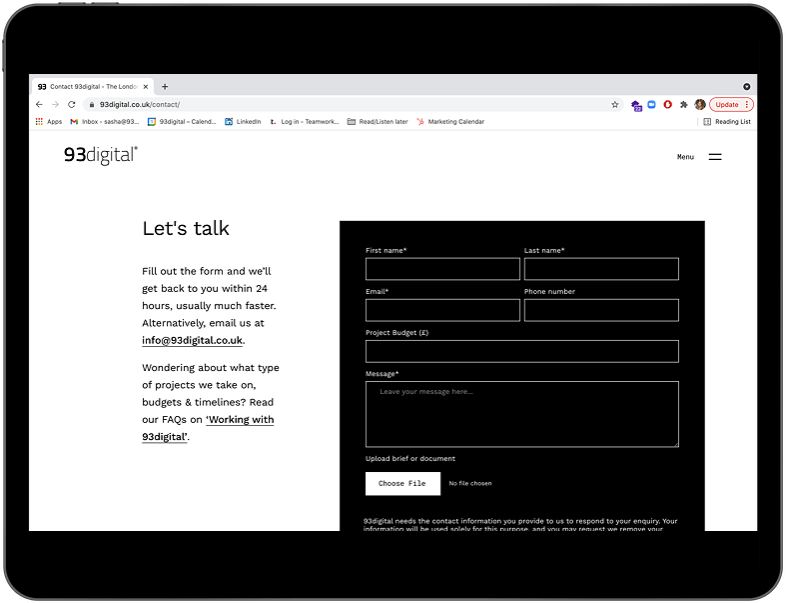How to Conduct A/B and Multivariate Tests for Conversion Rate Optimisation

Driving traffic to your technology website is merely the first step in an effective digital marketing strategy. Optimising your landing pages, not only for search, but also for conversion rate enhancement is crucial. What use is an effective SEO and paid ads strategy that falls flat against user expectations? Implementing A/B testing and multivariate testing is a fundamental tactic in this optimisation process, that will help your landing pages suit the needs of your prospects, and most importantly, convert!
What is conversion rate optimisation (CRO)?
Conversion Rate Optimisation (CRO) is the systematic process of making updates to your website, to increase the percentage of visitors who perform a desired action. This is done through a test and learn approach, understanding how your users meet and interact with your site.
For technology companies, the ultimate conversion goal often revolves around converting site visitors into actual customers – a significant leap termed as macro-conversion. However, there are several other micro-conversions, like downloading a free whitepaper, that play an essential role in the customer’s journey towards that final conversion. Tracking and optimising for both categories is key to a fruitful CRO strategy.
What is the difference between A/B tests and multivariate tests?
You can effectively test your web page performance by engaging in A/B testing and multivariate testing. These allow you to test changes before making them permanent, so that you can make data-driven decisions that suit your prospects. These varieties of split-testing are imperative for conversion rate improvement.
The distinction between A/B and Multivariate Testing Split testing verges on the number of variables you’re aiming to test on one web page.
A/B Testing
This form of testing entails changing a single element on a webpage and analyzing the impact. Possible changes could include modifying a CTA’s wording, adjusting the location of a “contact us” button, or tweaking the headline of your homepage. The performance of the original page (the control or ‘A’) is then compared against the new version (the challenger or ‘B’), but it is crucial to limit changes to one per test to maintain test integrity.
Multivariate Testing
This testing method allows for the alteration of multiple variables simultaneously to examine how these combined changes affect conversion. Unlike A/B testing which compares two versions of a page, multivariate testing can compare multiple variations at once (e.g., versions A, B, C, and D), providing a richer data set for decision-making.
When to Deploy A/B Testing and Multivariate Testing
The decision between A/B and multivariate testing should be based on the amount of web traffic you achieve, and your familiarity with CRO testing protocols. A/B testing is recommended for sites with lower traffic or for those new to CRO, while multivariate testing can expedite insights for those with higher traffic volumes and more experience in testing.
Guidelines for Implementing Successful A/B or Multivariate Testing
A successful testing strategy involves clear planning and the utilisation of CRO testing tools. If the management and execution of such tests seem beyond your current capabilities, partnering with a conversion rate optimisation agency is a beneficial move.
- Establish Your Conversion Objective
Define the action you wish to increase through your testing, whether it’s form submissions, whitepaper downloads, or button clicks, and by what percentage you aim to increase it.
- Formulate a Hypothesis
Develop a prediction of what you believe will happen as a result of your test. This hypothesis will drive the setup and execution of your testing strategy.
- Develop Testing Variations
Create different versions of your page to test various elements against each other, tailoring each variation to test your hypothesis effectively.
- Implement Conversion Tracking
Proper tracking setup is crucial for an accurate assessment of your test’s success. Metrics to monitor include page visits, conversion numbers, and overall website conversion rate. Using tools like Google Optimise can facilitate this process by managing how variations are presented to your audience.
- Determine Statistical Significance
Before running your test, define the statistical significance threshold to ensure confidence in your results. Tools and calculators are available to aid in this determination, ensuring your test runs until a conclusive outcome is reached.
Analyze and Act on Results
- Upon achieving statistical significance, analyze the outcomes against your hypothesis. Depending on the results, further testing might be necessary to refine your approach.
Additionally, A/B and multivariate testing aren’t limited to webpage elements; they can be used to assess sales funnel changes, landing page layouts, website navigation, PPC campaigns, and more. However, improper test execution can lead to issues, making adherence to best testing practices essential.
Getting started with CRO
Selecting a conversion rate optimisation agency, such as a specialist service familiar with the B2B tech sector, can significantly enhance your efforts in achieving higher conversion rates. Specialists understand the intricacies of B2B vs. B2C CRO and bring invaluable experience to the table.
If you’re interested in learning how conversion rate optimisation can delight your website users and drive conversions, contact us today.
Let's Talk
Do you have a web design and build project coming up that you would like to talk about?

How to add a HubSpot form to your WordPress site

How to use heat mapping for conversion rate optimisation
Let's Talk
Do you have a web design and build project coming up that you would like to talk about?